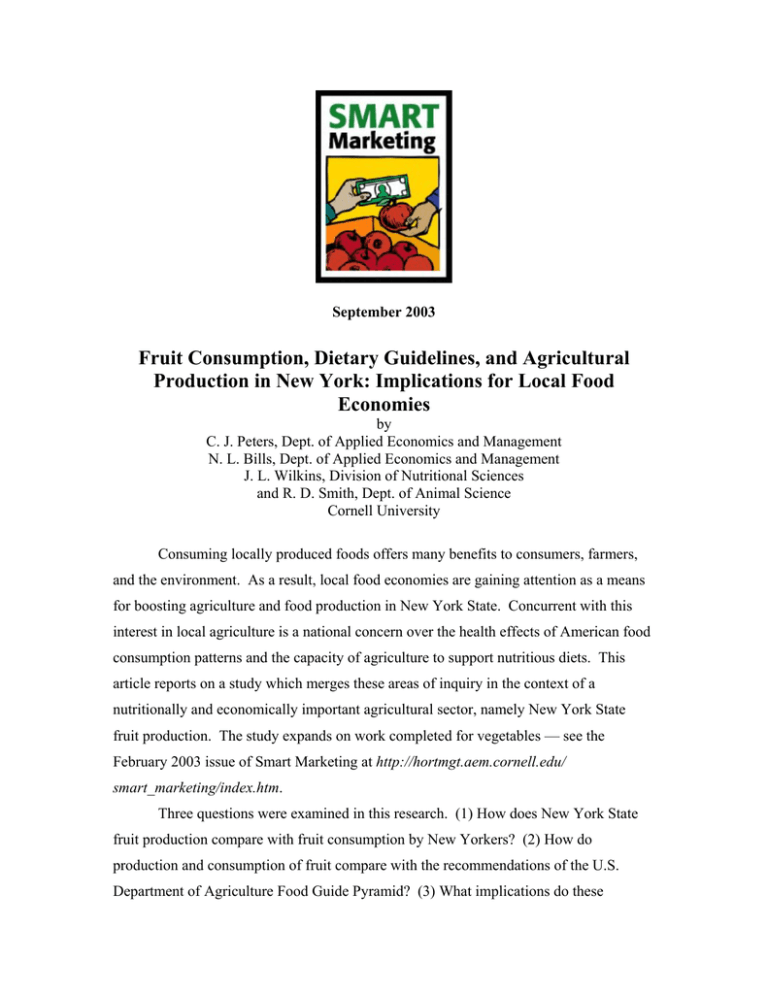Fruit Consumption, Dietary Guidelines, and Agricultural
advertisement

September 2003 Fruit Consumption, Dietary Guidelines, and Agricultural Production in New York: Implications for Local Food Economies by C. J. Peters, Dept. of Applied Economics and Management N. L. Bills, Dept. of Applied Economics and Management J. L. Wilkins, Division of Nutritional Sciences and R. D. Smith, Dept. of Animal Science Cornell University Consuming locally produced foods offers many benefits to consumers, farmers, and the environment. As a result, local food economies are gaining attention as a means for boosting agriculture and food production in New York State. Concurrent with this interest in local agriculture is a national concern over the health effects of American food consumption patterns and the capacity of agriculture to support nutritious diets. This article reports on a study which merges these areas of inquiry in the context of a nutritionally and economically important agricultural sector, namely New York State fruit production. The study expands on work completed for vegetables — see the February 2003 issue of Smart Marketing at http://hortmgt.aem.cornell.edu/ smart_marketing/index.htm. Three questions were examined in this research. (1) How does New York State fruit production compare with fruit consumption by New Yorkers? (2) How do production and consumption of fruit compare with the recommendations of the U.S. Department of Agriculture Food Guide Pyramid? (3) What implications do these comparisons have for New York State agriculture? These questions were addressed using secondary national and state data. We replicated some analyses that were previously conducted on a national basis by the USDA Economic Research Service to assure comparability with prior research. According to the most recent national food intake data, annual per capita consumption for the Northeast U.S. averaged 180 pounds between 1994-96. Based on this level of consumption, we estimate that New Yorkers ate approximately 3.2 billion pounds of fruit in calendar year 1999. In contrast, New York fruit growers harvested an average of 1.5 billion pounds of fruit annually during 1994-1998, of which just 816 million pounds was “consumable” after adjusting for weight changes that occur during processing (e.g. canning, freezing, juicing), post-harvest losses, and inedible portions. A handful of these products (fresh apples, processed apples, and processed cherries) were produced in quantities that exceeded the estimated in-state demand. As a result, we estimate that New York produced enough fruit to provide 18 percent of all the fruit New Yorkers consumed plus 256 million pounds of “surplus” of the aforementioned three commodities. Comparison of consumption with the Food Guide Pyramid demonstrates that, though fruit intake in the Northeast is higher than the national average, intake is still well below recommended levels. Based on current fruit consumption (1.9 servings per person per day), New Yorkers would need to increase consumption by 63% to reach the recommended intake. Current consumption is consistent with the Pyramid recommendation that intake be split evenly between the Vitamin C-rich “citrus, melons, and berries” and the catchall category “other fruit”. However, current dietary preferences may not satisfy the Pyramid suggestion that consumers should choose whole fruits most often. Juices presently comprise more than a third of all fruit servings. New York harvests enough fruit to provide 20% of this recommended intake, but production is not evenly distributed between the two subgroups. Almost all in-state production comes from fruits in the “other fruits” category (e.g. apples, grapes, and pears) while the production of melons and berries is insignificant relative to the recommended intake. 2 The results of this research suggest both opportunities and challenges to New York State’s fruit growers and consumers. For most fruits, the in-state market is large relative to current production. In addition, consumption of fruit needs to increase substantially to meet national nutritional goals. Taken together, these findings suggest potential for marketing more fruit, and more New York grown fruit, to New Yorkers. However, the length of the growing season and the predominance of just two crops, apples and grapes, bring into question the ability of New York’s fruit sector to provide the diversity needed to supply a more significant share of the state’s consumption. Moreover, current food preferences may limit sales of in-state produced fruit as over 60% of consumption comes from crops that cannot be grown in New York’s temperate climate. Despite these conflicting patterns, potential exists for growers to target local and regional markets, particularly if they can excite the palates of nutritionally conscious consumers. For a complete report of this study, please see “Fruit Consumption, Dietary Guidelines, and Agricultural Production in New York State – Implications for Local Economies” by Christian Peters, Nelson Bills, Jennifer Wilkins, and R. Dave Smith, RB 2003-02, Dept. of Applied Economics and Management, Cornell University (http://aem.cornell.edu/research/researchpdf/rb0302.pdf). "Smart Marketing" is a monthly marketing newsletter for extension publication in local newsletters and for placement in local media. It reviews the elements critical to successful marketing in the food and agricultural industry. Articles are written by faculty members in the Department of Applied Economics and Management at Cornell University. "Share the gift of communication." Please cite or acknowledge when using this material. 3




